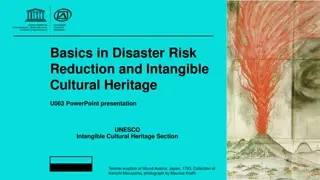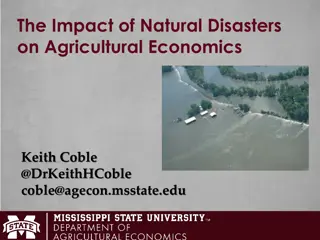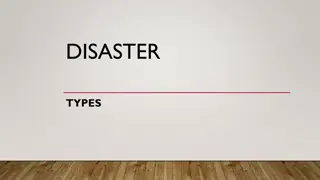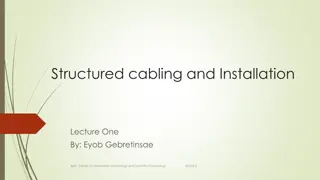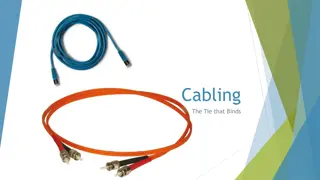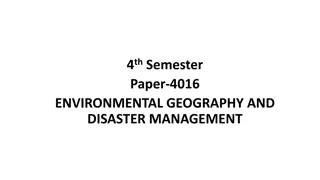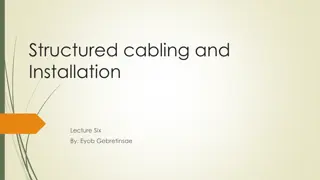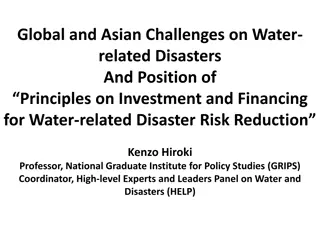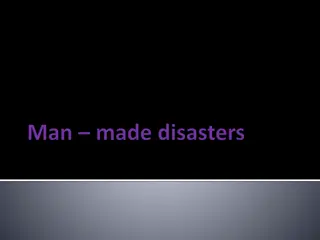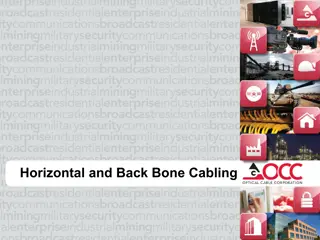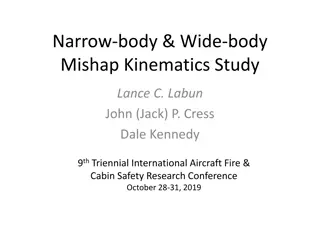Cost-Effective and Survivable Cabling Design under Major Disasters
Submarine fiber-optic cables play a crucial role in global communication, with an extensive network spanning thousands of miles. This study focuses on optimizing cabling design to enhance survivability during major disasters like earthquakes. By considering various network topologies and laying strategies, the aim is to balance cost-efficiency with network survival probability. The research explores practical applications beyond cabling, making it valuable for diverse infrastructure systems. Using explicit models and simulations, the work aims to identify optimal solutions that ensure network resilience in the face of catastrophic events.
Download Presentation

Please find below an Image/Link to download the presentation.
The content on the website is provided AS IS for your information and personal use only. It may not be sold, licensed, or shared on other websites without obtaining consent from the author.If you encounter any issues during the download, it is possible that the publisher has removed the file from their server.
You are allowed to download the files provided on this website for personal or commercial use, subject to the condition that they are used lawfully. All files are the property of their respective owners.
The content on the website is provided AS IS for your information and personal use only. It may not be sold, licensed, or shared on other websites without obtaining consent from the author.
E N D
Presentation Transcript
Cost Effective and Survivable Cabling Design under Major Disasters Name: Supervisor: Date: Cong CAO Prof. Moshe ZUKERMAN November 2015
Outlines Introduction Optimal Laying of a Single Cable Across an Earthquake Fault Line Three Connected Segments Hook with Right Angles Survivable Topology Design for 2-Node Networks Rectangular Topology Other simple Topologies Survivable Topology Design for N-Node Networks An N-Node Convex Polygon Topology An General N-Node topology Conclusion 2
Introduction: Submarine fiber-optic cables Carry almost 99% of the international voice and data traffic nowadays. A total of 285 submarine cables by the year 2014. 263 are currently in service. 22 will be in used by the end of 2015. Total length: over 550,000 miles (885139.2km). enough to circle the Earth 22 times. Average $2.2 billion worth of investment and 50,000 kilometers of deployment per year. 3
Submarine cable map (2014) Source: TeleGeography, URL: www.telegeography.com 4
Taiwan (Hengchun) Earthquake 2006 26th December 2006 7.1-magnitude South of Taiwan 7 submarine cables were knocked out of service Disruption of Internet services in Southeast Asia for several weeks Source: TeleGeography, URL: www.telegeography.com 5
Another example : Mediterranean Area 6
Overview How to lay cables between a given set of nodes positioned in a 2-dimensional plane considering major disasters? A multi-objective optimization problem with the two objectives: Cost Network (or cable) Survival Probability Although the work is presented in the context of cabling, it has many other applications: fuel or gas pipelines roads, railway tracks power lines 7
Approaches Develop tractable disaster models. disaster location disaster effects on the cables Consider various sets of network topology alternatives. or single cable shape alternatives Derive explicit expressions for the two objectives, or rely on simulations to evaluate them. Provide Pareto Fronts. Pareto Fronts: a set of points where it is impossible to make one objective better off without making the other objective worse off. 8
The Fundamental Problem: Optimal Laying of a Single Cable Across an Earthquake Fault Line 9
Optimal Laying of a Single Cable Across an Earthquake Fault Line Earthquake Fault Line (denoted by ?) ? is sufficient long (let the length be ?). One destructive earthquake happens at one time. Earthquake epicenter (denoted by ?) is uniformly distributed on ?. The probability density function of the earthquake epicenter ?: ? ? =1 ? 10
Disaster Model: Elliptical Failures The energy spreads along the earthquake fault line faster than other directions. For every point on a common ellipse, the earthquake effect is the same. Equivalent distance from ? to ? : Length of the semi-major axis of the ellipse where ? is located. ? ? : the equivalent distance from ? to the cable. 11
Disaster Model: Cable Break Probability A point closer to the epicenter ? in terms of the equivalent distance than another implies stronger motions and higher cable break probability. Conditional Cable Break Probability (given an earthquake epicenter is ?): ? ????? ?) = ? ? ? ? : a general monotonically decreasing function. Without loss of generality, for our numerical results, we use q(d S ) = ? ?(?). Cable Break Probability: ?(?????) = ? ?? ????? ?) ?(?) ??, 1 ?is the probability density function of the epicenter ?. where ? ? = 12
Cable Shape Alternative: Three Connected Segments (TCS) Three cable segments: N1D, DE, EN2 N1DC N2EC : the angle between DE and y-axis T: the length of DE ( T 0) affect both Cost and ?(?????) 13
Cable Shape Alternative: Hook with Right Angles (HRA) Three cable segments: N1D, DE, EN2 N1D AB, DE AB , EN2 DE H: the length of EN2 ( H 0) affect both Cost and ?(?????) 14
Survivable Topology Design for 2-Node Networks 15
Survivable Topology Design for 2-Node Networks: Problem Description Design cable topologies where best to lay multiple cables in a cost effective way to maintain connectivity following a major disaster. Network Survival Probability: It represents the probability that all nodes in the network are still connected, when a disaster happens. Another related concept is the Network Disconnection Probability. Cost: multiple types undersea cable cost. inland cable cost. 16
Disaster Model: Circular Disk Failures Reflect key properties of many disasters: Small-scale earthquakes, WMD, EMP, etc. S Assume only one major disaster occurs at one time. Probability density function: fS,R (?, r) = fS (?)fR (r) , Epicenter ? : fS (?) is the density of a uniform distribution of the world (denoted by ). Radius?: fR (r) is exponentially distributed with parameter , which is fR (r) = e- r. Any cable situated in the disaster region will be disconnected. 17
Network Survival Probability Assume that two nodes are connected by K cables. Let ??? (i = 1,2, , K) be the shortest distance from the disaster epicenter ? to the ith cable. If max ?1? , ,??? < ? , the network is disconnected. ? ???????? = 1 ? ????????????? = 1 ??? ??? ?? ??. max ?1? , ,??? ? 18
Rectangular Topology a K = 2 Recall the assumptions: 1. Only one major disaster at one time. 2. All cables within disaster area break. 3. Unlimited capacity of each cable. Then, PK(Survivability) = P2(Survivability). K > 2 19
Other Network Topologies Rhombus topology Rounded-corner rectangular topology Pareto Fronts for the three topologies 20
Insights Gained From 2-Node Cases Cable Segmentation: City Segment Main Segment Variable a: The distance between main segment and the line that connects two cities. Affect both cost and network survival probability. Angle between two city segments 21
Survivable Topology Design for N-Node Networks 22
Survivable Topology Design for N-Node Networks: An N-node Convex Polygon Topology For N-node (N 3) models (the N nodes must form a convex polygon) : The main segments are laid parallel to the corresponding edges of the polygon with distance a. The city segments are laid perpendicular to the bisector of each angle of the polygon. Obtain the optimal value of variable asubject to meeting network survival probability requirement. The hexagon topology for a general triangle. 23
Survivable Topology Design for N-Node Networks: A General N-Node Case How to lay cables for a general N-Node case, if the N nodes can t form a convex polygon? For Example : y The network survival probability requirement is given 0.93. x 24
A general N-node case (contd) Even all cables between any pair of nodes are straight lines, the number of possible topologies is 2N(N-1)/2 . We allow cables to be segmented (not to be straight lines). Difficult to obtain analytical results. Rely on simulations. The optimization problem (where a simulation is used to compute the value of the objective function) is computationally prohibitive. Therefore, we resort to a heuristic algorithm. due to limited computing time and computing power. get feasible solutions (not optimal solution). can be further improved by human sense. 25
The Heuristic Algorithm Stage 1: connecting the external nodes Divide N nodes into two set. External Nodes: The maximal set of nodes that can form a convex polygon. Internal Nodes: The remaining nodes that are located inside the polygon. Connect all external nodes by using the previous approach. the approach of N-Node Convex Polygon Topology. Find the minimum aout such that the survival probability meets the requirement. When aout= 0, the network survival probability is 0.936. Meet the requirement (0.93). 26
Stage 2: Connecting the internal nodes by straight lines Connect each internal node to two nodes that are already connected use two straight lines. In each step, choose the internal node that incurs the minimal cost to connect it. After all nodes are connected, compute the network survival probability by simulations. If the survivability constraint is not met, choose the next least cost option, and continue. Given that the number of options is large, we limit the number of attempts to M in each step (M is based on the computing power). Then we have a list of instances to connect all the nodes with or without meeting the survival probability constraint. Table 1: six instances in Stage 2 27
Stage 3: Improvement by multiple segments per link For each Stage 2 instance, consider segmented links. Use 2 city segments and 1 main segment to replace the straight-line links. Consider different ain and aout for internal and external links. Begin with the instance of low cost in the list. Use a branch and bound approach. Increase the parameters ain and aout for each instance until the survivability constraint is met, and calculate the cost. Repeat the process for the next Stage 2 instance until either the survivability constraint is met, or the cost exceeds the cost of other feasible instances. 28
Stage 3: Improvement by multiple segments per link (Example) The list of the instances from Stage 2. The order: (AE,BE), (AE, CE), (AE, DE), (BE, CE), (BE, DE), (CE, DE) The First instance in the list: (AE, BE): Lay city segments on Node E perpendicular to the bisector of AEB. Lay two main segments parallel to AE and BE, Lay city segments on Node A and B perpendicular to bisectors of EAB and EBA, respectively. Stage 2 Stage 3 29
Stage 3: Improvement by multiple segments per link (Example) Increase the value of ainand aout. Find a solution (ain= 0.1, aout= 0.1). Table 2: results for the first instance (AE, BE). Table 1: six instances of Stage 2 The cost of this solution 43.93 is lower than the costs of the remaining five instances in list of Stage 2. No need to consider these five instances further into Stage 3. 30
A 7-Node Example (4 external & 3 internal nodes) A 7-Node Example Stage 1 31 An instance in Stage 2 An instance in Stage 3
Conclusion We have consider the problem of how to lay a singe cable between two nodes across an earthquake fault line. Three Connected Segments (TCS). Hook with Right Angles (HRA). We have considered the problem of how to lay multiple cables (including the undersea and the inland parts) between two nodes, under a major disaster. Rectangular Topology Rhombus Topology Rounded-corner Rectangular Topology We have further extended the discussion to a network with multiple nodes. An N-node Convex Polygon Topology The Heuristic Algorithm for a general N-node case 32
Publication & Submission C. Cao, M. Zukerman, W. Wu, J. Manton, and B. Moran, ''Survivable topology design of submarine networks,'' Journal of Lightwave Technology, vol. 31, no. 5, pp. 715-730, March 2013. C. Cao, Z. Wang, M. Zukerman, J. Manton, A. Bensoussan, and Y. Wang, ''Optimal cable laying across an earthquake fault line considering elliptical failures,'' submitted for publication. 33
The End Thank You 34
Appendix 35



